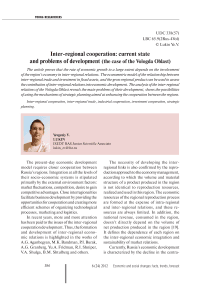Inter-regional cooperation: current state and problems of development (the case of the Vologda oblast)
Автор: Lukin Yevgeniy Vladimirovich
Журнал: Economic and Social Changes: Facts, Trends, Forecast @volnc-esc-en
Рубрика: Young researchers
Статья в выпуске: 6 (24) т.5, 2012 года.
Бесплатный доступ
The article proves that the rate of economic growth to a large extent depends on the involvement of the region's economy in inter-regional relations. The econometric model of the relationship between inter-regional trade and investment in fixed assets, and the gross regional product can be used to assess the contribution of inter-regional relations into economic development. The analysis of the inter-regional relations of the Vologda Oblast reveals the main problems of their development, shows the possibilities of using the mechanisms of strategic planning aimed at enhancing the cooperation between the regions.
Interregional cooperation, interregional trade, industrial cooperation, investment cooperation, strategic planning
Короткий адрес: https://sciup.org/147223411
IDR: 147223411 | УДК: 338(57)
Текст научной статьи Inter-regional cooperation: current state and problems of development (the case of the Vologda oblast)
The present-day economic development model requires closer cooperation between Russia’s regions. Integration at all the levels of their socio-economic systems is stipulated primarily by the external environment factors: market fluctuations, competition, desire to gain competitive advantages. Close interregional ties facilitate business development by providing the opportunities for cooperation and creating more efficient schemes of organizing technological processes, marketing and logistics.
In recent years, more and more attention has been paid to the issues of the inter-regional cooperation development. Thus, the formation and development of inter-regional economic relations is highlighted in the works of A.G. Aganbegyan, M.K. Bandman, P.I. Burak, A.G. Granberg, Yu.A. Fridman, R.I. Shniper, V.A. Shulga, B.M. Shtulberg and others.
The necessity of developing the interregional links is also confirmed by the reproduction approach to the economy management, according to which the volume and material structure of a product produced in the region is not identical to reproduction resources, realized and used in this region. The economic resources of the regional reproduction process are formed at the expense of intra-regional and inter-regional relations, and these resources are always limited. In addition, the national revenue, consumed in the region, doesn’t directly depend on the volume of net production produced in the region [19]. It defines the dependence of each region on the inter-regional economic integration and sustainability of market relations.
Currently, Russia’s economic development is characterized by the decline in the centra- lization of the social and economic policy. Enhancing the role of the regional factor has been the logical consequence of the decrease of the state regulation and the crisis of national economy after the collapse of the Soviet Union.
In the times of planned economy, numerous cooperation and production relations between the republics and regions of the USSR were characterized by consistency and stability due to their prescriptive regulation by the state. The collapse of the centralized system of regional development management and economic instability had a significant influence on the territorial division of labour. A significant decline in economic activity, the close up of production facilities, the destruction of cooperation ties and technological production chains increased the closure of the regional markets.
Therefore, it can be stated that until 1999 Russia’s regions established economic ties on their own. The governments of the republics, krais and oblasts signed bilateral cooperation agreements, and such types of inter-regional interaction served as links between the regions.
The establishment of the new units of the country’s territorial division, the Federal Districts, in 2000 changed the situation significantly [9]. The Decree of the RF President “On the Plenipotentiary of the President of the Russian Federation in the Federal District” states that the districts are established “to ensure the realization of the constitutional powers by the President of the Russian Federation, to enhance the efficiency of activities of the federal bodies of state power and to improve the system of control over the execution of their decisions”. As a result, along with a “mild” form of integration processes development (formation of various cooperative organizations), there emerged the “hard” form, which was the creation of state structures and regional executive and legislative power bodies in macro-regions.
By the end of 2002, the system of Federal Districts has been finally integrated in the relations between the centre and the regions, occupying an intermediate position. Economic functions of the Federal Districts consisted in the strategic coordination of regional development, investment activity and interregional relations [15].
Currently, the strengthening of interregional ties is continuing. Inter-regional cooperation serves as one of the priority directions of regional development, being the sphere of special interests of the federal authorities. This is due to the fact that it facilitates the rapprochement of the regional economies, the reduction of territorial disparities in the socio-economic development of the regions and the strengthening of economic ties between the regions; besides, it plays an important role in strengthening the country’s federative structure and the development of the regional and, consequently, national economy as a whole [9].
Development of inter-regional economic cooperation has become an important task for the majority of Russian regions, as well as for the Vologda Oblast, which is one of the regions included into the North-Western Federal District.
The Vologda Oblast is an industrially developed, export-oriented region. It specializes in metallurgical and chemical production, forestry, machinery and equipment, meat and dairy products production (tab. 1) . The oblast enterprises carry out the primary processing of iron ore and apatites from the northern regions of the North-Western Federal District, as well as the oblast’s own forest resources and their subsequent realization in other regions of the country.
According to some researchers, the extent of involvement of the region’s economy in inter-regional relations largely determines its economic growth [2, 3]. To confirm this hypothesis it is proposed to use the econometric
Table 1. Export of products from the regions of the North-Western Federal District in 2010*
|
Type of production |
о |
E о ^ о |
о < |
о § |
о |
о |
о о |
о |
00 |
Share of the Vologda Oblast |
|
|
in the NorthWestern Federal District |
in Russia |
||||||||||
|
Rolled ferrous metal products, thousand tons |
– |
– |
– |
3845 |
– |
– |
– |
– |
197 |
95.1 |
17.4 |
|
Steel pipes, thousand tons |
– |
– |
– |
291 |
– |
– |
– |
– |
453 |
39.1 |
4.5 |
|
Industrial wood, thousand m3 |
245 |
566 |
600 |
2116 |
– |
212 |
217 |
39.7 |
– |
53.0 |
33.4 |
|
Saw timber, thousand m3 |
28.3 |
40.4 |
20.3 |
82.4 |
1.1 |
149 |
77.3 |
3 |
– |
20.5 |
7.8 |
|
Meat, thousand tons |
2.4 |
0.03 |
– |
3.6 |
4.5 |
108.6 |
55.2 |
8.8 |
– |
1.9 |
– |
|
Tinned meat, thousand standard cans |
– |
– |
– |
52.3 |
126442 |
8818 |
43566 |
292 |
1447 |
0.03 |
– |
|
Sausage products, tons |
69.9 |
11.3 |
1.3 |
724 |
13728 |
21295 |
7196 |
62574 |
11258 |
0.6 |
– |
|
Cheese, tons |
– |
– |
13.7 |
53.2 |
3.9 |
408 |
248 |
7435 |
19809 |
0.2 |
– |
|
Butter, tons |
4.4 |
– |
0.2 |
549 |
– |
401 |
1369 |
539 |
10117 |
4.2 |
– |
|
Flour, tons |
7.9 |
– |
– |
43.7 |
– |
– |
– |
1.1 |
42.9 |
45.7 |
1.3 |
|
Grain, tons |
281 |
– |
– |
8947 |
– |
– |
– |
1 |
70 |
96.2 |
1.7 |
* Source: Regions of Russia. Socio-economic indicators: stat. collection. Rosstat. Moscow, 2011. P. 728 – 739.
model of the relationship between the interregional trade and investment in fixed capital and the gross regional product, which provides a quantitative assessment of the impact of a limited set of factors on the region’s economy. As applied to the Vologda Oblast, the model is as follows:
Y = 36,5 + 1,3 • X + 0,9 • I,
R = 0,98; R2 = 0,96;
SY = 18,1; F(2;8) = 94,4, where Y is the volume of the gross regional product (billion rub.);
X is the volume of inter-regional export (billion rub.);
I is the volume of investments in the fixed capital (billion rub.).
The assessment of parameters of the multivariate regression was carried out by the least spreads method (tab. 2) .
In order to assess the validity (quality) of the regression analysis, the standard error SY (18,1) was used, which gives an idea about the approximate value of the forecast error, and the coefficient of determination R2 (0,96), which shows what percentage of the Y variation is explained by the influence of the selected components (i.e., the factor indicators explain 96% of the variation of the initial function). These values have confirmed that the considered components are very strong and statistically important.
The regression coefficients allow the average change in the “response” of GRP to be estimated with the change in the volume of inter-regional export or investments in fixed capital by 1 billion rubles, if the other factors are “frozen”. So, the increase in the volume of inter-regional export by 1 billion rubles at the fixed value of other parameters leads to the growth of the oblast’s GRP by 1.3 billion rubles, the increase in volume of investments by 1 billion rubles – to the growth of GRP by 0.9 billion rubles.
The calculations show that the absolute increment of GRP at a possible change in the volume of inter-regional export exceeds the increment, resulting from the increase of the volume of investments in fixed capital.
Table 2. The results of application of the multivariate regression
|
Standardized rate |
Standard error |
Coefficient |
Standard error |
t(8) |
p-level |
|
|
Free term |
36.519 |
11.278 |
3.238 |
0.012 |
||
|
Inter-regional export (X) |
0.449 |
0.193 |
1.317 |
0.568 |
2.320 |
0.049 |
|
Investments in fixed capital (I) |
0.548 |
0.193 |
0.869 |
0.307 |
2.834 |
0.022 |
Figure 1. The share of export to the regions of Russia in the total volumes of supplies of the Vologda Oblast organizations, %*
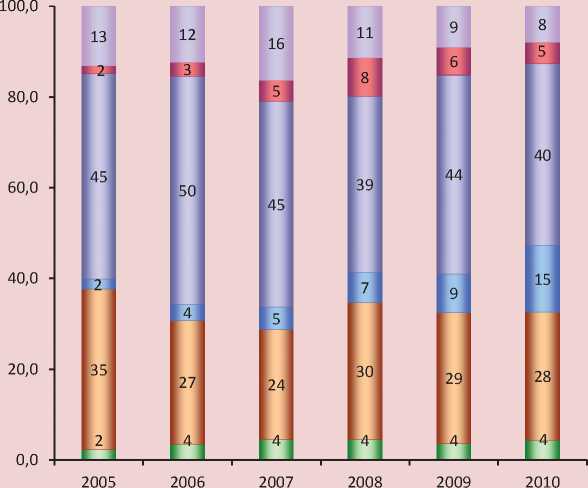
п Real estate transactions о Transport and communication о Production and distribution of electric power, gas and water о Manufacturing
□ Agriculture, hunting and forest management
Other
This phenomenon is explained by the great dependence of the Vologda Oblast’s economy on the volume of production, exported to other regions of Russia.
The importance of the development of inter-regional trade for the Vologda Oblast’s economy is also confirmed by the fact that about a half of its production is exported to other Russian regions (fig. 1), mostly to the Central Federal District (44% – in 2010), the Volga Federal District (25%) and the NorthWestern Federal District (16%). Besides, 2/3 of the regional goods market is formed by the imports from other RF subjects, mainly from the North-Western (in 2010 – 48%), Central (20%) and Volga (16%) federal districts.
In general, the main counterparties of the oblast, judging by its economic relations, developing for many years, include the Republic of Komi, the Murmansk Oblast, the Nizhniy Novgorod Oblast, Moscow and the Moscow Oblast, Saint Petersburg and the Leningrad Oblast, the Kemerovo, Yaroslavl and Samara oblasts, Perm Krai.
The structure of the inter-regional supplies of the Vologda Oblast is largely based on the resources and raw materials (fig. 2) . Metallurgical production, e.g. rolled ferrous metal
Figure 2. Share of the groups of the goods in the inter-regional exports of the Vologda Oblast in 2005 and 2010, %*
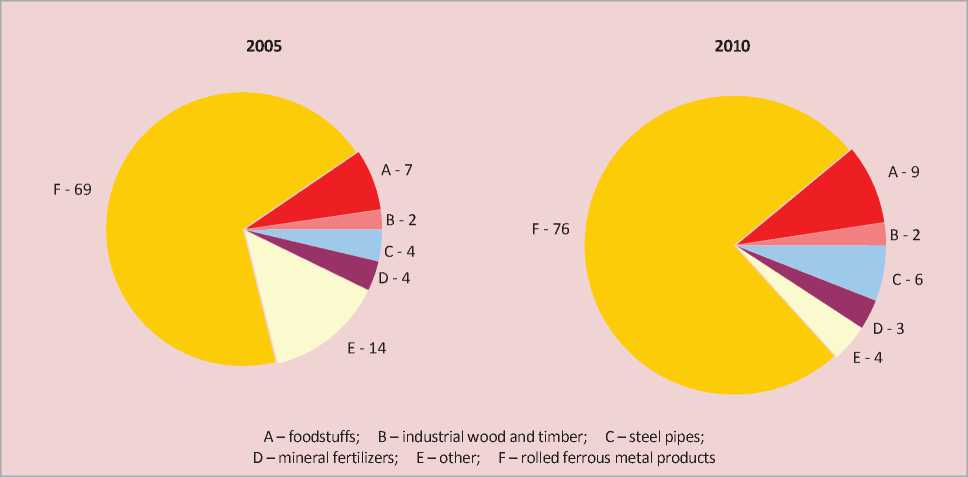
* Calculation sources: Inter-regional commodities exchange of the Vologda Oblast: stat. collection. Vologdastat. Vologda, 2010; Supply of consumer goods and industrial and technology products in 2010: stat. bulletin. Vologdastat. Vologda, 2011.
products and steel pipes, prevail in the export. Important export items are the products of chemical industry and timber industry complex, foodstuffs.
In the two decades of economic reforms, the development of inter-regional trade has not contributed to the improvement of the region’s industrial structure concerning its balance1. The narrow range of products exported from the oblast, the basis of which is formed by a small group of goods with a low degree of processing, led to the fact that the Vologda Oblast economy is not immune to external risks.
The 2008 global economic crisis revealed the instability of the oblast’s economy and had a negative impact not only on its inter-regional trade, but also, as a consequence, on its economy on the whole (fig. 3). A slump in prices for the few goods, which form the basis of the Vologda export, proved that.
Thus, the dependence of the region’s economy on the situation in the foreign markets is a factor of instability.
In order to reduce the dependence on the factors of external environment, organizations of the Vologda Oblast cooperate with those of other Russian regions. Meanwhile, the dynamics of the main indicators of the interregional cooperation in the 2005 – 2010 can’t be considered positive. For instance, the number of joint ventures reduced significantly (by 35%), as well as the number of their employees (by 31%), the volume of investments in fixed capital (by 57%) and manufacturing (by 16%; tab. 3 ).
Only the largest joint ventures function successfully. In 2010 they engaged 8.5% of the
-
Figure 3. Inter-regional trade turnover and the gross regional product of the Vologda Oblast in 2005 – 2010, billion rub. (in the prices of 2010)*
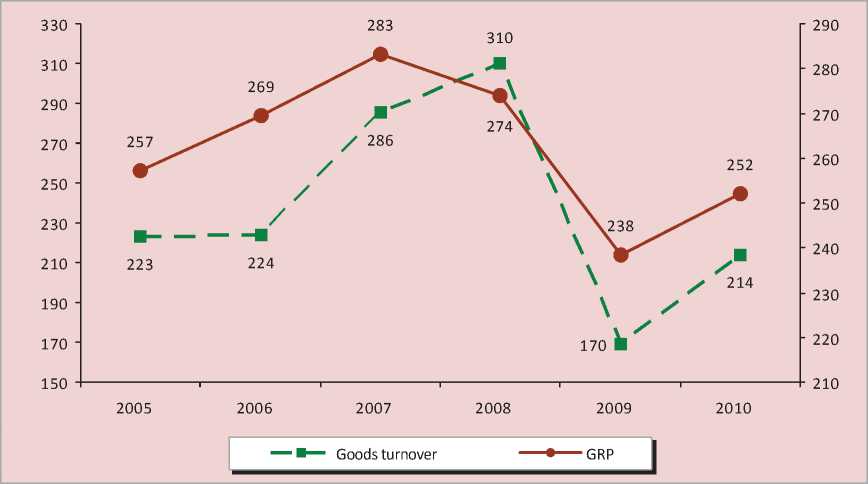
* Calculation sources: Inter-regional commodities exchange of the Vologda Oblast: stat. collection. Vologdastat. Vologda, 2010; Statistical yearbook of the Vologda Oblast: stat. collection. Vologdastat. Vologda, 2011.
Table 3. Main indicators of the functioning of joint inter-regional enterprises of the Vologda Oblast (in the prices of 2010)*
The main direction of joint investment projects is the manufacturing industry (in 2005 – 81%, in 2010 – 66% of the volume of investments in the fixed capital of joint interregional enterprises; fig. 4 ).
-
Figure 4. Structure of investments in joint inter-regional enterprises of the Vologda Oblast in 2005 and 2010, %*
В; 81,2
B; 65.7
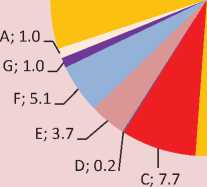
E; 3.3
А; 1.2
G; 0.6
F; 0.5

D; 1.3
С; 27.4
А - agriculture; B - manufacturing;
C – production and distribution of electric power, gas and water; D – transport and communication; E – financial activities; F – real estate transactions; G – other
* Calculation source: Investment processes in the Vologda Oblast: stat. collection. Vologdastat. Vologda, 2006, 2011.
There were 51 joint manufacturing enterprises, functioning in 2010. Among them 16 enterprises were engaged in food production, 12 – in machine-building, 7 – in pulp-and-paper production, 6 – in ferrous metallurgy and metal-working, 3 – in textile production, 2 – in woodworking, 2 – in chemical production.
Vologda enterprises together with the enterprises of other regions establish facilities for the advanced processing of metal, wood and chemicals on the territory of the Vologda Oblast. However, the most important direction for the oblast, the joint production of final products, isn’t practically developing. At the end of 2010 metallurgical production accounted for 63% of the turnover of joint ventures, chemical – for 14%, foodstuffs production – for 8%.
Thus, the joint enterprises of the Vologda Oblast are created in the sectors producing goods with a low degree of processing.
This underlines the raw-material character of the region’s economy and its passive role in the national differentiation of labour [12].
Structural adjustment of the real sector of the economy can be intensified through investment cooperation. Investments allow the production to be timely upgraded, the sphere of the enterprise’s activity to be expanded, and the level of work safety to be increased.
Inter-regional investment cooperation is complicated by the fact that each region, possessing its resource potential, isn’t eager to share it with other regions. Only the potential economic benefit can urge them to do it. Such an attitude is correct from the point of view of market relations. However, the region can’t develop in isolation from other regions. Therefore, it is necessary to strengthen interregional investment ties at the macro-regional (district) level.
The Federal Districts promote the pooling of federal and regional resources, aimed at the socio-economic development of the regions; besides, they facilitate the joint decision of problems when the regions are unable to solve them on their own; they also promote the development of productive forces at the interregional level [18].
At the same time, the regions, different in their level of economic development, can coordinate their efforts under the Federal Districts, they can be comprehensively integrated and gain a certain economic and social effect, by addressing the issues of the territory’s socio-economic development independently, without attracting significant funds from the federal budget.
At present, the process of federalization of the country requires the consideration of regions as the subjects of civil law and economic relations having their own economic interests [4]. At the same time, one should not forget that the region is an open socio-economic system which includes many interrelated links and which is connected with other regions of the country, as well as foreign states. The importance of the relations between the RF subjects for the development of sustainable federal relations leads to the necessity of their strengthening, in particular, in the investment sphere.
The Federal Law “On the investment activity in the form of capital investments” provides for the possibility of investment interaction in the sphere of capital investments between the state power bodies of the Russian Federation, the state power bodies of the subjects of the Russian Federation and local self-government bodies with the coordination of their interests2. The availability of the required investment resources remains an open issue.
According to Rosstat (Federal State Statistics Service of Russia), the North-Western Federal District (NWFD) annually accounted for 13 – 14% of the total investments of the country in 2005 – 2010 (in general for the period – over 6 trillion rubles). The greatest volume of investments was directed to Saint Petersburg, the Leningrad Oblast and the Republic of Komi (tab. 4) .
The Vologda Oblast in recent years has become unattractive for investments: the volume of investments in fixed capital in 2005 – 2010 dropped by 38% (the worst figure in NWFD), and the region’s share in the total volume of investments in NWFD decreased from 11.5% to 5.5%.
The leading Russian rating agency Expert-RA explains the decrease in the investment attractiveness of the Vologda Oblast by the growth of investment risks (mainly because of the deteriorating economic and management components) and by the decrease of the investment potential (because of the deterioration of consumer, industrial and financial components).
Investors are mostly interested in such branches of the economy, as transport and communication, and manufacturing (mainly metallurgical and chemical), 40% and 28% of the investments, respectively, were directed there in 2010 (in 2005 – 45% and 35%; fig. 5 ) .
Four of the top ten largest investment projects are funded by the investors from other regions of Russia (Moscow-based companies OJSC OGK-6 and Alliance Group, LLC Nestle Russia and Yaroslavl-based JSC TGK-2; tab. 5 ), two projects in the food sector and two – in the energy sector.
The development of the Vologda Oblast’s inter-regional investment cooperation demonstrates the same skew in the structure of industry toward the production of goods with the low degree of processing. As for hi-tech industries, in particular, mechanical engineering, they remain unattractive for Russian investors.
Table 4. Volume of investments in the fixed capital of organizations in the NWFD regions, billion rubles (in the prices of 2010)
|
Region |
2005 |
2006 |
2007 |
2008 |
2009 |
2010 |
2010 in % to 2005 |
|
NWFD |
800.1 |
978.5 |
1107.6 |
1174.1 |
992.1 |
1049.6 |
131.2 |
|
Leningrad Oblast |
145.6 |
196.5 |
170.1 |
188.8 |
203.4 |
269.3 |
184.9 |
|
Novgorod Oblast |
23.6 |
29.8 |
32.9 |
40.4 |
39.5 |
39.7 |
168.3 |
|
Saint Petersburg |
258.4 |
293.8 |
416.9 |
423.1 |
352.5 |
375.0 |
145.1 |
|
Pskov Oblast |
10.9 |
13.8 |
21.4 |
22.0 |
16.3 |
15.2 |
139.3 |
|
Komi Republic |
78.1 |
105.3 |
79.2 |
90.2 |
112.5 |
102.6 |
131.4 |
|
Murmansk Oblast |
33.3 |
37.4 |
35.8 |
54.9 |
44.8 |
35.0 |
105.3 |
|
Arkhangelsk Oblast |
76.8 |
128.8 |
166.4 |
158.4 |
78.9 |
78.6 |
102.4 |
|
Republic of Karelia |
22.2 |
25.0 |
23.2 |
28.5 |
19.4 |
22.3 |
100.5 |
|
Kaliningrad Oblast |
54.9 |
50.7 |
62.3 |
83.7 |
66.0 |
54.6 |
99.4 |
|
Vologda Oblast |
92.2 |
92.7 |
96.2 |
82.6 |
59.1 |
57.3 |
62.1 |
|
11.5* |
9.5* |
8.7* |
7.0* |
6.0* |
5.5* |
-6.0 p.p.. |
* Share of the Vologda Oblast in NWFD.
Source: author’s calculations based on: Main indicators of development of NWFD regions: stat. collection. Vologdastat. Vologda, 2011.
Р. 205.
-
Figure 5. Structure of investments in the fixed capital of the Vologda Oblast, %*
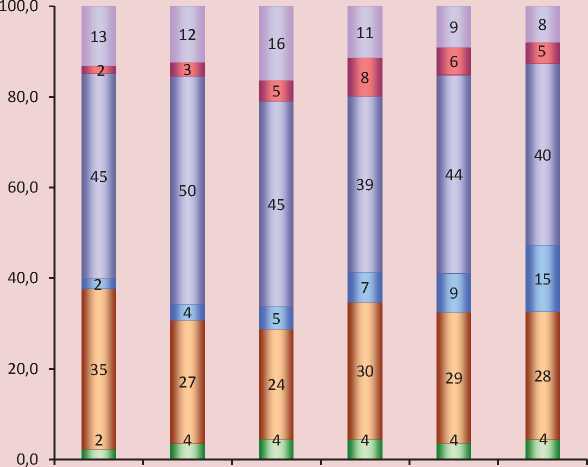
2005 2006 2007 2008 2009 2010
□ Other
п Real estate transactions
-
□ Transport and communication
-
□ Production and distribution of electric power, gas and water
-
□ Manufacturing
о Agriculture, hunting and forest management
Table 5. Major investment projects implemented in the Vologda Oblast
№ Project name Industry Implementation period Investor Amount of investments, billion rubles 1 Second construction stage of the Cherepovets state district power station Energy 2009-2014 OJSC OGK-6 18,6 2 Flax complex of the Vologda Oblast Textile 2008-2020 JSC Vologodsky Textile, agricultural producers 9,8 3 Carbamide production unit Chemical 2008-2012 OJSC Cherepovetsky Azot 7,8 4 Combined cycle gas turbine unit PGU-110 consisting of a gas-turbine installation GTU 75 MW + heat recovery steam generator + steam turbine 35 MW Energy 2007-2012 OJSC TGK-2 5,9 5 Cultivation of small fruit crops on the basis of industrial technologies Food 2009-2013 OJSC Alliance Group 4,9 6 Reconstruction of existing paper manufacturing Wood processing 2010-2016 OJSC Sukhonsky Pulp and Paper mill 4,1 7 Industrial Park Sheksna Metal working 2006-2015 Vologda Oblast Government 2,7 8 Air separation unit Metallurgy 2011-2012 ZAO Air Liquide Severstal 2,0 9 Development of value added production Wood processing 2009-2013 OJSC Sokolsky DOK (Wood Processing Plant) 1,2 10 Layout of baby food production in Vologda (second stage) Food 2011-2015 LLC Nestle Russia 1,0 Source: Major investment projects under implementation in the Vologda Oblast. Available at: ekonomika-severo-zapada/media/ 146274
The expansion of the regional enterprises’ participation in the inter-regional industrial cooperation, along with investment cooperation, depends on the results of economic reforms and, first of all, on the creation of favorable conditions for the attraction of investors and development of the industry.
The smart strategic planning of the economy, based on the principles of sustainable and innovation development and taking into account the strengthening of inter-regional economic links, is a key tool for achieving these objectives [11, 16, 17, 20].
Several attempts to create the institutional framework for the implementation of a sustainable and systemic approach to the organization and management of interregional cooperation processes have been made at the level of the North-Western Federal District. The strategy for the socio-economic development of the North-Western Federal District for the period up to 2020 approved by the RF Government on 18 November 2011 is an important document defining the strategic direction of the district’s regional policy and inter-regional relations. This document makes an attempt to use strategic planning for the large group of the RF subjects. The strategy is mainly aimed at creating the conditions, which will ensure rapid and sustainable economic growth in the RF subjects included in the North-Western Federal District. The document focuses on the development of the North-West as a single economic space within the framework of the single economic space of Russia.
This goal is to be achieved by implementing the set of measures aimed at the strengthening of inter-regional integration. It is expected that the stabilization of local markets, the intersectoral and inter-regional integration of scientific-technological and production potential, the implementation of mutually beneficial strategic inter-regional projects will have a multiplicative effect on the economy of the North-West.
The essential point of the strategy is its consideration of the fact that under the current conditions of market relations, inter-regional cooperation can not develop on the directive basis. The regions should have a clear notion of the economic feasibility of such integration. It is proposed to work out the long-term programme documents on the socio-economic development, i.e. regional strategies, as a mechanism for the coordination of interests.
However, the analysis of strategic documents of the NWFD regions showed that not all the strategies emphasize the role of inter-regional cooperation as an important factor of regional development. Only 6 of the documents contain the notion that it is possible to achieve more through the pooling of competitive advantages of the neighbouring regions, the development of inter-regional cooperation and stimulation of inter-regional integration, than by competing for external resources (the strategy for the socio-economic development of the Vologda Oblast for the period up to 2020 the issues of strengthening the inter-regional ties are barely touched upon).
In addition, the problems of strategic planning in the regions include the lack of strategic guidelines on the mechanisms of formation and regulation of the policy in the sphere of inter-regional cooperation.
Another major problem is the absence of the long-term vision, coordinated at the district level, concerning the total export capacity, as well as the improvement of investment climate and the efficient use of competitive advantages [1]. The regions’ executive and legislative authorities are to form a coordinated approach to the management of integrated economic complex. The systemic problems of socioeconomic development require the elaboration of special methodology of evaluating the interregional cooperation projects and programmes, allowing the use of modern mechanisms and principles of territorial economic management and interaction.
Thus, taking into account modern theoretical and methodological principles in the sphere of inter-regional cooperation, the results of the analysis of the Vologda Oblast’s inter-regional relations, one can draw the following conclusions.
-
1. It is necessary to study the inter-regional economic and cooperative ties comprehensively, which is difficult at the moment due to the low degree of openness and transparency of the information on the state and dynamics of their development. The region’s economic growth depends largely on the degree of involvement of its economy in inter-regional relations.
-
2. For the sustainable development of the regional economy and reduction of its dependence on the world market situation, the share of inter-regional export and intra-regional consumption should amount to not less than 2/3 of the total volume of supplies of production produced in the region. The export-oriented strategy to the detriment of domestic consumers is untenable [10, 14].
-
3. The state authorities should use all the available administrative and economic tools for the strengthening and development of cooperative relations between industrial enterprises (in different districts, regions and Federal Districts), the technological process of which is aimed at the production of goods with high added value.
-
4. The development of investment cooperation between the regions should be coordinated at the federal and district levels. Investment projects should be implemented in the priority sectors of the national economy in accordance with the strategies and concepts of the development of Russia and its Federal Districts.
-
5. Strategic documents on the regional development should include the sections, containing clearly defined and agreed directions and mechanisms of inter-regional cooperation. The interaction of the regional executive and legislative authorities should be also aimed at eliminating the barriers to inter-regional
cooperation, creation of joint projects, providing administrative support to the enterprises producing high-tech goods. The efficiency of using the mechanisms of strategic planning in the sphere of inter-regional cooperation will be enhanced by the following:
– the setting of goals, tasks and priorities of inter-regional cooperation, the promotion of public awareness of inter-regional cooperation processes and coordination of the long-term vision of the total export capacity at the district level;
– the regions’ strategies should take into account the measures on the development of the inter-regional relations, a mechanism should be developed aimed at ensuring their inter-regional coordination, systematic monitoring of inter-regional cooperation processes, as well as the formation of the system of strategic priorities (based on the analysis of the essence of inter-regional cooperation), which will be fixed in the corresponding document in the framework of the regional strategic planning system.
Список литературы Inter-regional cooperation: current state and problems of development (the case of the Vologda oblast)
- Bazhenov Yu.N., Podshuveit O.V. Problems and prospects of the development of the external economic activity of Saint-Petersburg, the Leningrad Oblast and the Republic of Karelia. Baltic region. 2012. No. 1. P. 70-80.
- Blokhin K.A. The impact of the region's external economic ties on the development of the single economic space of Russia (the case of Krasnodar Krai): author's published summary of the Ph.D. in Economics thesis: 08.00.01. Moscow, 2007.
- Yelkin I.V. The impact of the development of the export potential on the region's economy and growth of population's welfare. Izvestiya of Irkutsk State Academy of Economics. 2008. No. 3 (59). P. 105-108.
- Investments: system analysis and management. Ed. by K.V. Baldin. Moscow: Dashkov and Co., 2007.
- Krasnopolskiy B.Kh. Spatial-economic planning: the experience of the United Kingdom (on the report “The framework of the national planning policy”) Spatial economics. 2012. No. 2. P. 168-173.
- Mezhevich N.M., Zhuk N.P. Strategic planning in the sphere of cross-border cooperation: experience of the North-Western Federal District of the Russian Federation. Available at: http://forum.euroregion.ru
- Prygunov A.I. Prospects of development of the regional economic system in the North-West of Russia. Vestnik of MSTU. 2007. No. 4. P. 680-692.
- Putin V.V. On our economic goals. Vedomosti. 30 January 2012. No. 15 (3029).
- Development of Russian regions: new theoretical and methodological approaches. Institute of the problems of regional economics of RAS. Ex. ed. Ye.B. Kostyanovskaya. Saint Petersburg: Nauka, 2006.
- Romanova O.A., Tatarkin A.I. Structural policy and development. Available at: http://www.ecfor.ru/pdf.php?id=2003/4/04
- Samarukha A.V. The directions of strategic planning of inter-municipal, inter-regional and international cooperation and interaction in the Baikal region. Izvestiya of Irkutsk State Academy of Economics. 2009. No. 3 (65). P. 52-56.
- Smirnova T.G., Lukin Ye.V. The role of economic cooperation of territories in the development of the industry (the case of the Vologda Oblast). Problems of development of territories. 2011. No. 2 (54). P. 14-24.
- The strategy of socio-economic development of the North-Western Federal District for the period up to 2020. Available at: http://www.minregion.ru/upload/documents/2012/01/230112/230112_2074_r_str.pdf
- Tatarkin A.I., Romanova O.A., Basargin V.F., et. al. Strategic priorities of socio-economic development of the Ural Federal District for the period up to 2010: conceptual basis of stabilization and dynamic modernization. Yekaterinburg: Ural RAS Department, 2001.
- Turovskiy P. Main questions of the theory and practice of Federal Districts: the political-geographical approach. Available at: http://www.bastion.ru/files/eb/feddistrict.doc
- Uskova T.V. Overcoming the barriers of inefficient economy -the requirement of time. Problems of development of territories. 2012. No. 2 (58). P. 7-17.
- Uskova T.V. The region's sustainable development management: monograph. Vologda: ISEDT RAS, 2009.
- Cherkasov K.V. Federal Districts in Russia: state and development trends. Available at: http://www.juristlib.ru/book_3829.html
- Shniper R.I., Novoselov A.S. Regional problems of marketology. Novosibirsk: Nauka, 1993.
- Developing a Strategic Plan. Available at: http://www.planware.org/strategicplan.htm

